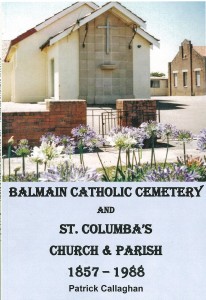Patrick Callaghan attended St. Columba’s primary school between about 1940 and 1945 and fifty years later when writing his family history, he recalled seeing fallen headstones in the ‘out of bounds’ area of the school grounds. His first inquiries about the possibility of their having ever been a cemetery on this site led to several dead ends but eventually he discovered that between 1868 and 1902 the land which now houses St. Columba’s church, presbytery and school was originally acquired to provide a local Catholic cemetery for the people of the then very extensive Balmain parish of St Augustine and thus the Balmain Catholic cemetery came into being..
By the 1950’s all traces of the old cemetery had disappeared and even worse the burial register had been lost. The end result was that it seemed that a cemetery had never existed on that site and that if there had been a cemetery there, no one had any idea of who and how many had been buried there.
Patrick then set himself the task of writing the history of the cemetery and the church and school which followed. The book details the establishment and growth of both the original church of St. Columba’s and the Holy Souls (to give the church it’s full title) which opened in 1898 and was extended in 1917 plus the original school building which opened in the 1920’s and the presbytery which opened in 1938.
The school has been extended several times as the population grew………. The land for the cemetery was acquired by Father John Joseph Therry in a gentlemen’s handshake deal from James Norton. How this land deal came about between a committed Catholic and a committed Protestant makes fascinating reading. Many historians regard John Joseph Therry as the founder of the Catholic church in Australia and through its links to Father Therry, St Columba’s church and school have important historical links to the earliest days of Catholicism in Australia.
Many former students of St. Columba’s school were interviewed as part of putting this book together and some humorous stories were recalled, not the least of which was the night the priest’s vestments caught alight during an evening service.
Parishioners memories of the first four parish priests at St. Columba’s are also included in the book, together with a list of all the St. Josephs nuns who worked or lived at St Columba’s.
However, finding those buried in the Balmain Catholic cemetery was a different kettle of fish, the lack of any available burial records made it impossible to know how many were buried in the old cemetery, so Patrick set himself the goal of finding and recording 1000 of those buried in this old cemetery.
This proved to be a monumental ten year task, which is now complete and in addition to the book mentioned above he has produced a searchable CD of the 1000 burials discovered in the Balmain Catholic cemetery.
About 25 sets of remains were moved to other cemeteries but most of those buried in the Balmain Catholic cemetery remain where they were originally laid to rest and those attending the church or school have the bones of many Balmain pioneers beneath their feet. Most were ordinary people of Balmain and Leichhardt but there are some notable exceptions, John Greenway Punch being one, he was a master mariner, ship owner, a well known businessman and a Balmain councillor, he, and his wife and son were buried in the Balmain Catholic cemetery and in 1931 their remains and their impressive headstone was moved to Northern Suburbs cemetery. Many family groups were buried in the old cemetery, Tancred was a well known Balmain name and more than 20 of that name were buried in the old cemetery.
The CD of the burials lists all those found and the source of the information .and will be a boon for those family historians who suspect their relatives may have been buried in this old cemetery.Patrick is always happy to do look ups for those interested in burials in this cemetery and is always on the look out for additional information or stories about the cemetery or the church and school which followed. He can be contacted by email at: balcolyn@activ8.net.au The CD may be purchased by contacting Patrick direct.
the book is now for sale at Leichhardt Library for $20.00
 opened a legal practice in Sydney, became very successful, eventually becoming a member of the NSW Legislative Assembly, His name was James Norton. In 1834 Norton bought a large gentleman’s estate, known as the Eastwick Estate and which included a large house, befitting for a wealthy gentleman known as Eastwick House. The estate was roughly bounded by Parramatta Rd, Balmain Rd. Derbyshire St. William St. and Flood St. back to Parramatta Road.
opened a legal practice in Sydney, became very successful, eventually becoming a member of the NSW Legislative Assembly, His name was James Norton. In 1834 Norton bought a large gentleman’s estate, known as the Eastwick Estate and which included a large house, befitting for a wealthy gentleman known as Eastwick House. The estate was roughly bounded by Parramatta Rd, Balmain Rd. Derbyshire St. William St. and Flood St. back to Parramatta Road.
